Caesar Salad Dressing
If you are craving a creamy classic restaurant-style Caesar salad, but don’t want to leave the comfort of your own home, then you are in luck! I am sharing my easy-as-can-be 5-minute recipe for classic homemade dressing that will be the star of your Caesar salad bowl!
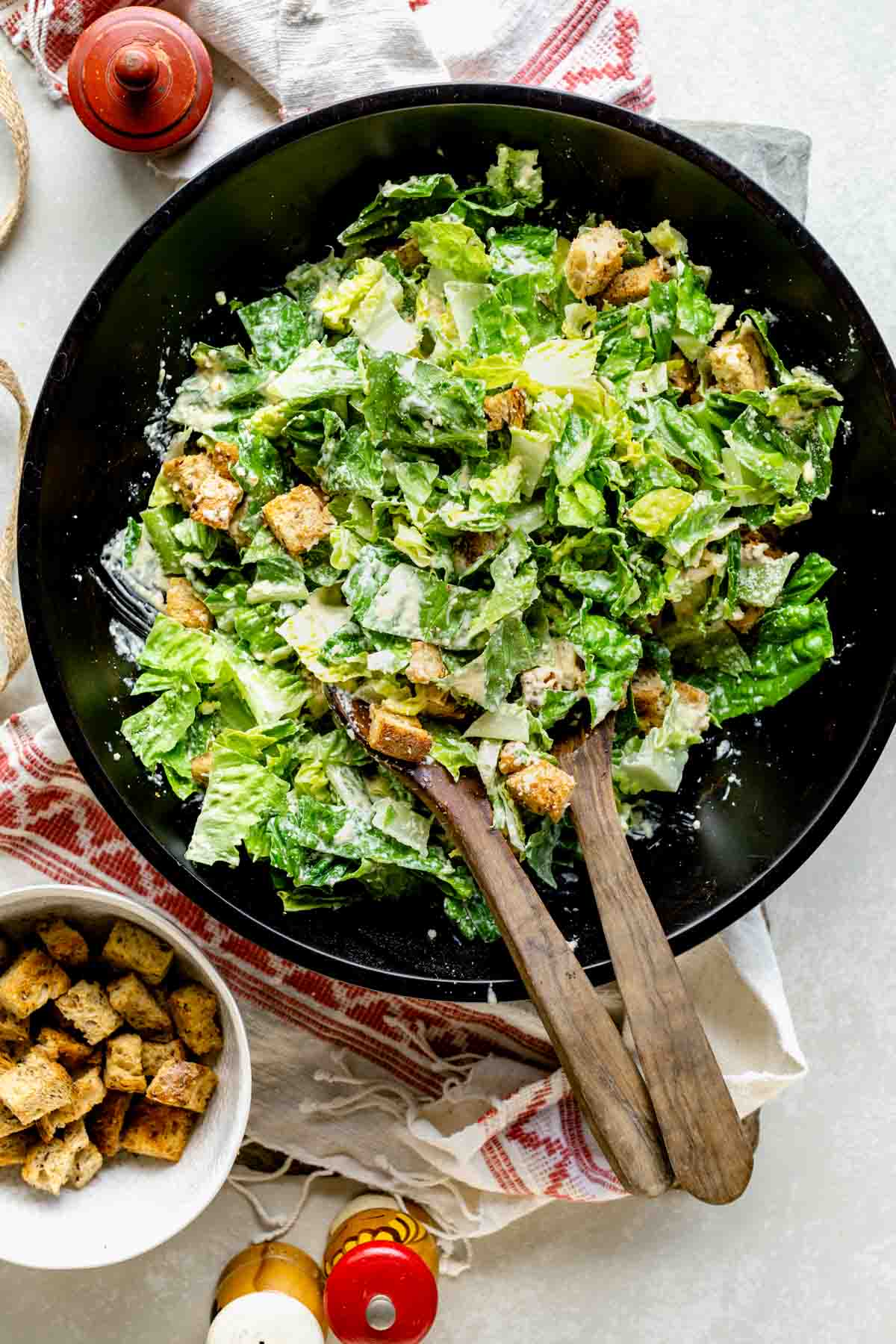
DISCLOSURE: This post contains affiliate links. Consuming raw or undercooked meats, poultry, seafood, shellfish, or eggs may increase your risk of foodborne illness.
Table of contents
- Why We Love This Homemade Caesar Salad Dressing
- Caesar Dressing Ingredients
- How To Make This Caesar Dressing Recipe
- Ratios For The Perfect Caesar Salad
- FAQs and Expert Tips For The Best Caesar Salad
- How long does Caesar salad dressing last?
- Can you make Caesar dressing without anchovies?
- A note on salt
- Other Mixing Methods
- What To Serve with Caesar Salad?
Why We Love This Homemade Caesar Salad Dressing
This classic Caesar dressing was literally the first recipe I learned on my first day working as a restaurant line cook when I was a culinary school intern. I made it hundreds of times working in that kitchen, and though that was nearly 25 years ago, if put to the test today- I think I would still be able to do it blindfolded. That’s how much this Caesar recipe is second nature to me!
Today I have all the details you need to make it yourself. From there, all you need is some crisp Romaine lettuce, crunchy croutons and Parmesan cheese to toss it all together. So if your family is like mine and loves a good Ceasar, then you will be a dinner hero tonight!
Now, before we get to the recipe, I do have to warn you, this Caesar dressing is extremely thick and creamy due to the fact that it has a raw egg yolk in it. So if you are not up for that, then the good news is I have a Caesar Salad Dressing without Eggs for you folks. Head over there if that is you! But if you are up for making your dressing in the traditional way, with a raw yolk, then tighten up your apron strings- this dressing is a game changer!
More Caesar Salad Recipes
Here are some more Caesar salad variations I have shared over the years, so if you are as obsessed about Caesar as I am, then you’ll want to check these out too!
Caesar Dressing Ingredients
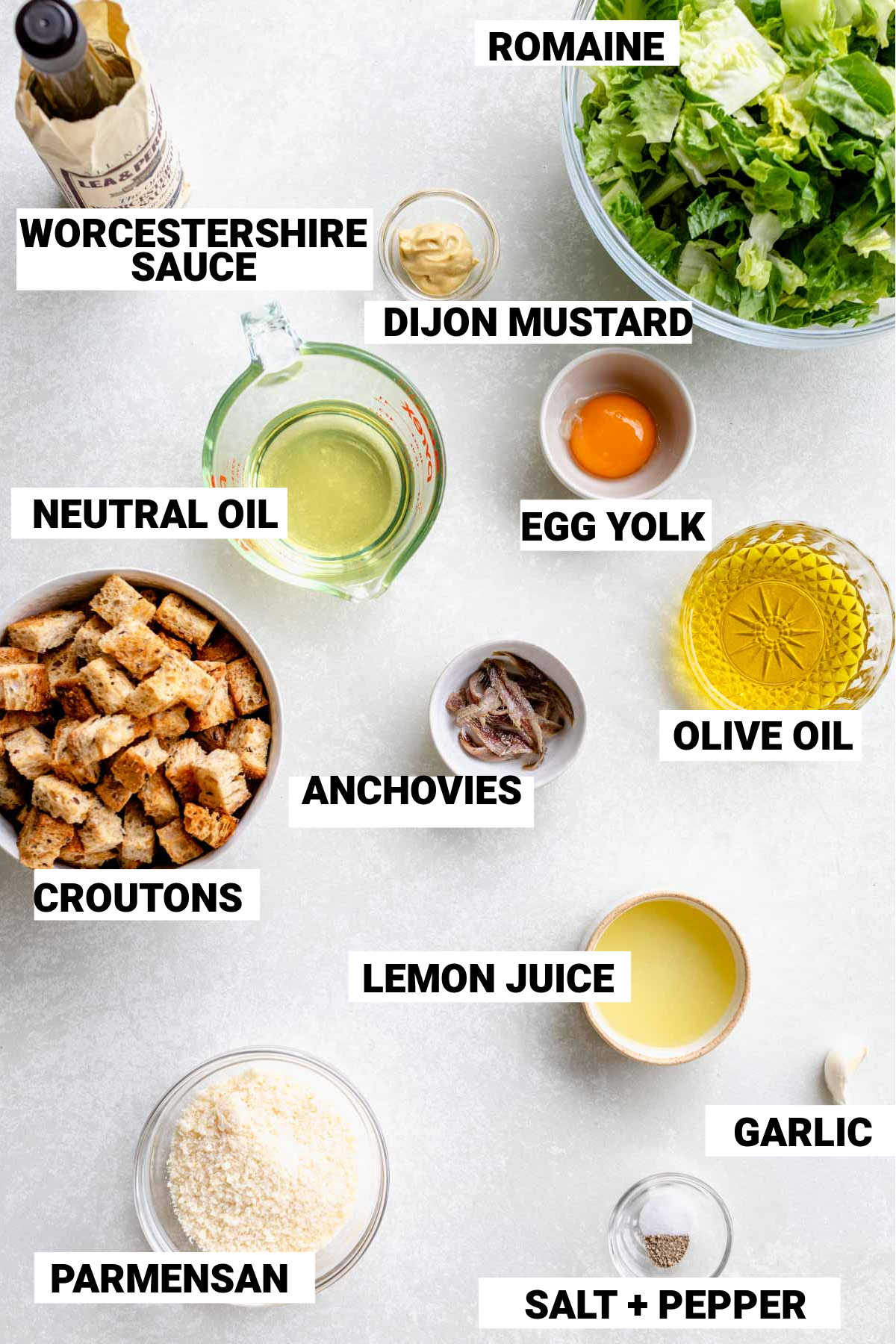
- Anchovies: You can use either anchovy filets or anchovy paste. Recently anchovies have been added to the list of seafood that has been overfished, so I have been buying canned anchovies so that I am sure the ones I am using are sustainable. Do not use white anchovies- they are too pickled tasting and not salty enough. Save them for garnish if you like.
- Raw Egg Yolk: The reason classic Caesar dressing has egg yolk in it is that yolk has naturally occurring lecithin in it. Lecithin is an emulsifier which helps to bind the oil in the dressing to the liquids to hold it in suspension. Some recipes call for mayonnaise as a work around- but it will not make the dressing as creamy as this one! I guarantee it!
- Garlic: You’ll want a whole clove of garlic. For the best authentic flavor- do not use jarred garlic or garlic powder- the best Caesar is a sum of its parts- and you don’t want second-rate parts.
- Lemon juice: The key to a good Caesar dressing (besides the creamy texture) is to find the perfect balance of acidity to salt. In the case of a classic Caesar salad dressing – the acidity comes from fresh lemon juice. I like a brightly acidic dressing- so I use three tablespoons lemon- but if you are not a fan of sour flavor, you can use slightly less (2 tablespoons) and add more to taste after it is all blended together. Some Caesar salad dressing recipes call for vinegar- but this is not traditional.
- Dijon mustard: If you have ever had a table side Ceasar dressing then you know that Dijon mustard is a classic component of Cesar Dressing. I use Dijon in a lot of my dressing recipes because (like egg yolk) it also has natural emulsifiers which help make the dressing creamy. It also adds great tangy peppery flavor that is a key component of a classic Caesar!
- Worcestershire sauce: The original Caesar Dressing I made as a Culinary intern did not have Worcestershire sauce in it, but I personally love it when it is added to a table side Cesar salad- so I make mine that way too. It adds a savory tang that I love! Feel free to omit it if you don’t have it on hand.
- Oil: I use a blend of avocado oil (or another neutral oil) and olive oil. Extra-virgin olive oil is too strong on its own for Caesar dressing- it makes it bitter. So I find that the perfect balance is using mostly neutral oil with about 1/3 olive oil.
- Parmesan cheese: I use pre-grated Parmesan cheese (from the refrigerated deli section of the supermarket) for Caesar dressing. It blends in best. I use a half cup in the dressing and then add some to the salad as I toss it with the dressing. You can use freshly grated Parmigianno Regianno if you happen to have it on hand and prefer to grate it by hand. Or you can sub in another hard Italian cheese such as Asiago or Romano- but watch out on the added salt as they are saltier than Parmigiano Reggiano.
- Salt and pepper: I added a small amount of salt and pepper to the dressing in this recipe. You’ll want to adjust that after you toss with the lettuce and croutons. More on the balance of salt is below.
For The Caesar Salad
To make this dressing into the best Caesar Salad you’ll want chopped Romaine Lettuce (washed and spun dry.) You can also use this dressing to make a kale Caesar salad by swapping in cleaned chopped kale leaves.
You’ll also need some croutons. If you don’t have time to make them from scratch, here are my favorite store-bought croutons for Caesar. I like the butter garlic-flavored ones best. That isn’t an affiliate link- just a favorite brand!
See our tips for the perfect proportions of dressing to greens.
How To Make This Caesar Dressing Recipe
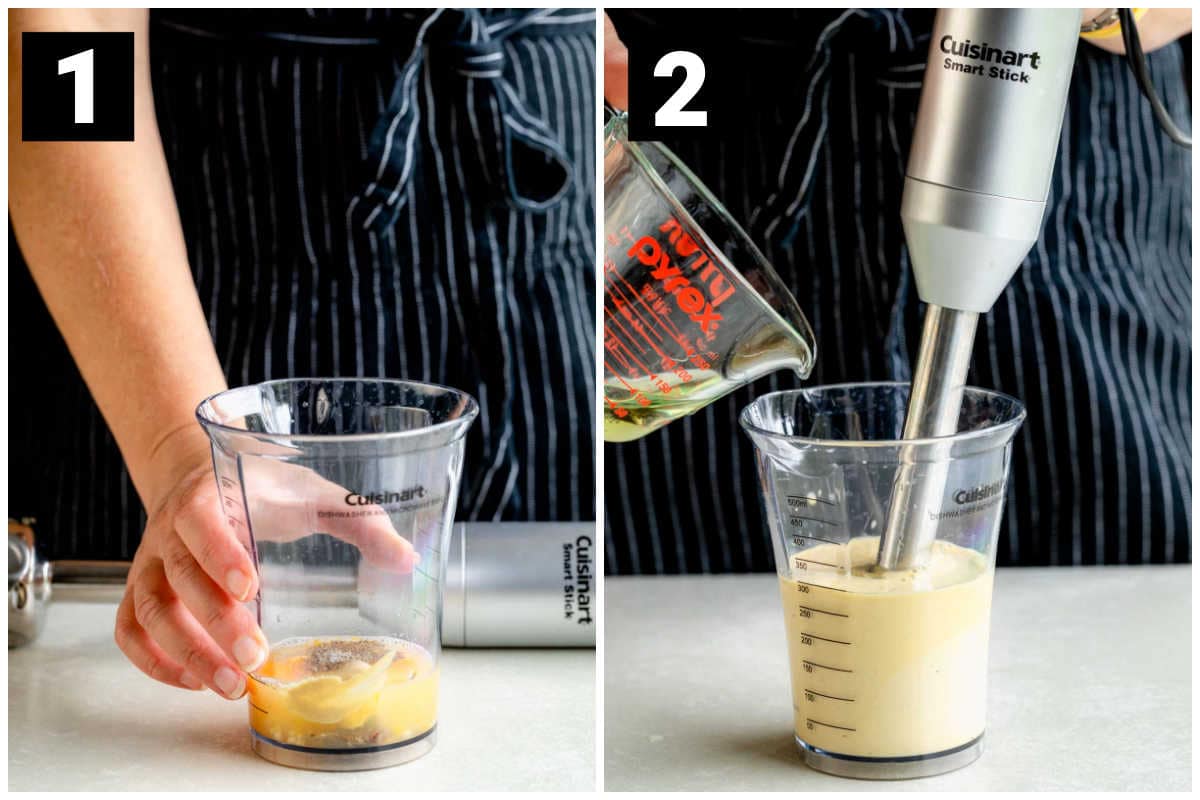
Step 1: Add Dressing Ingredients To Blending Jar
Combine anchovies, egg yolk, garlic, lemon, Dijon and Worcestershire in a blending jar, blender or mini prep. Puree with an immersion blender, blender or mini prep. You can also mix it by hand, see our notes on how to do that.
Step 2: Emulsify with Oil
Add avocado oil and olive oil and puree until thick and completely combined.
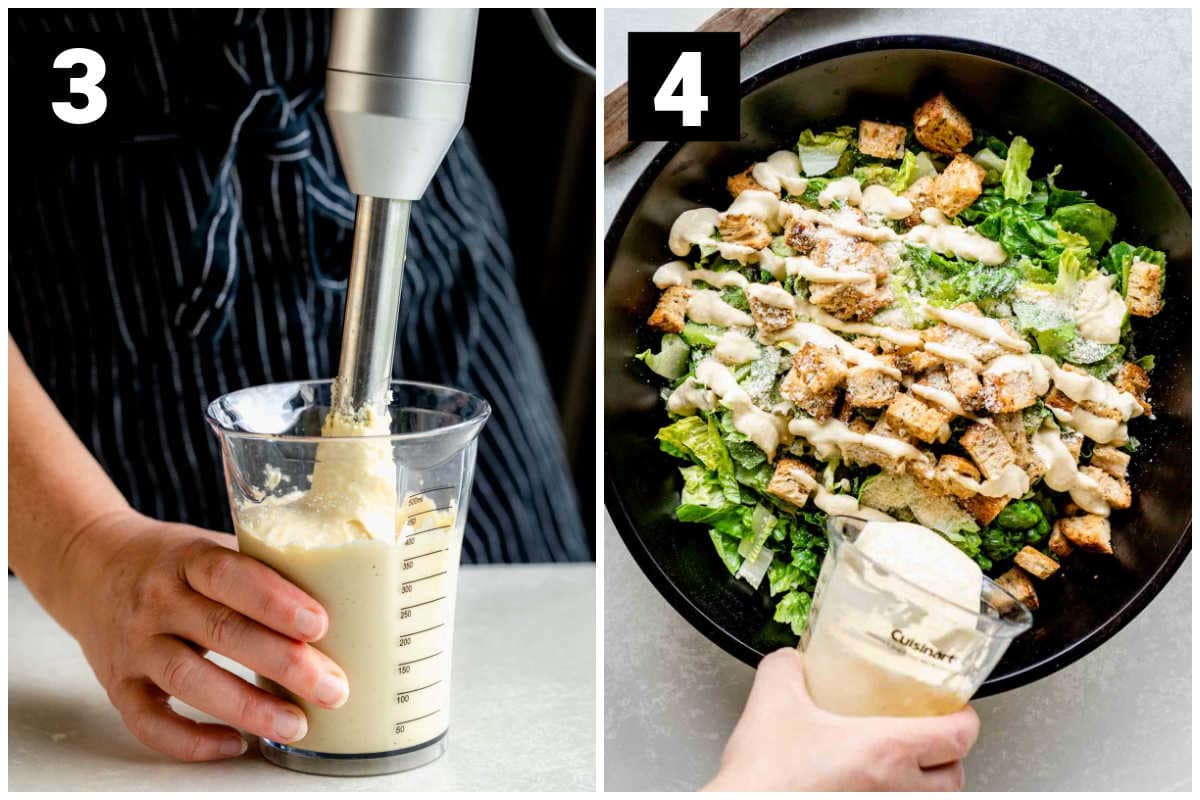
Step 3: Add Cheese
Add in ½ c Parmesan cheese and salt and puree. Keep refrigerated until ready to use.
Step 4: Toss with Salad
Drizzle the dressing over the salad and toss to combine.
Pro tip: When I use this dressing for a big bowl of Caesar, or particularly when I use it to make a kale Caesar salad, I like to toss it by hand with gloved hands! This is how we always did it in the restaurant and it makes all the difference! It is easier to get the thick and creamy dressing into all the nooks and crannies of each leaf and you won’t have any big globs of dressing.
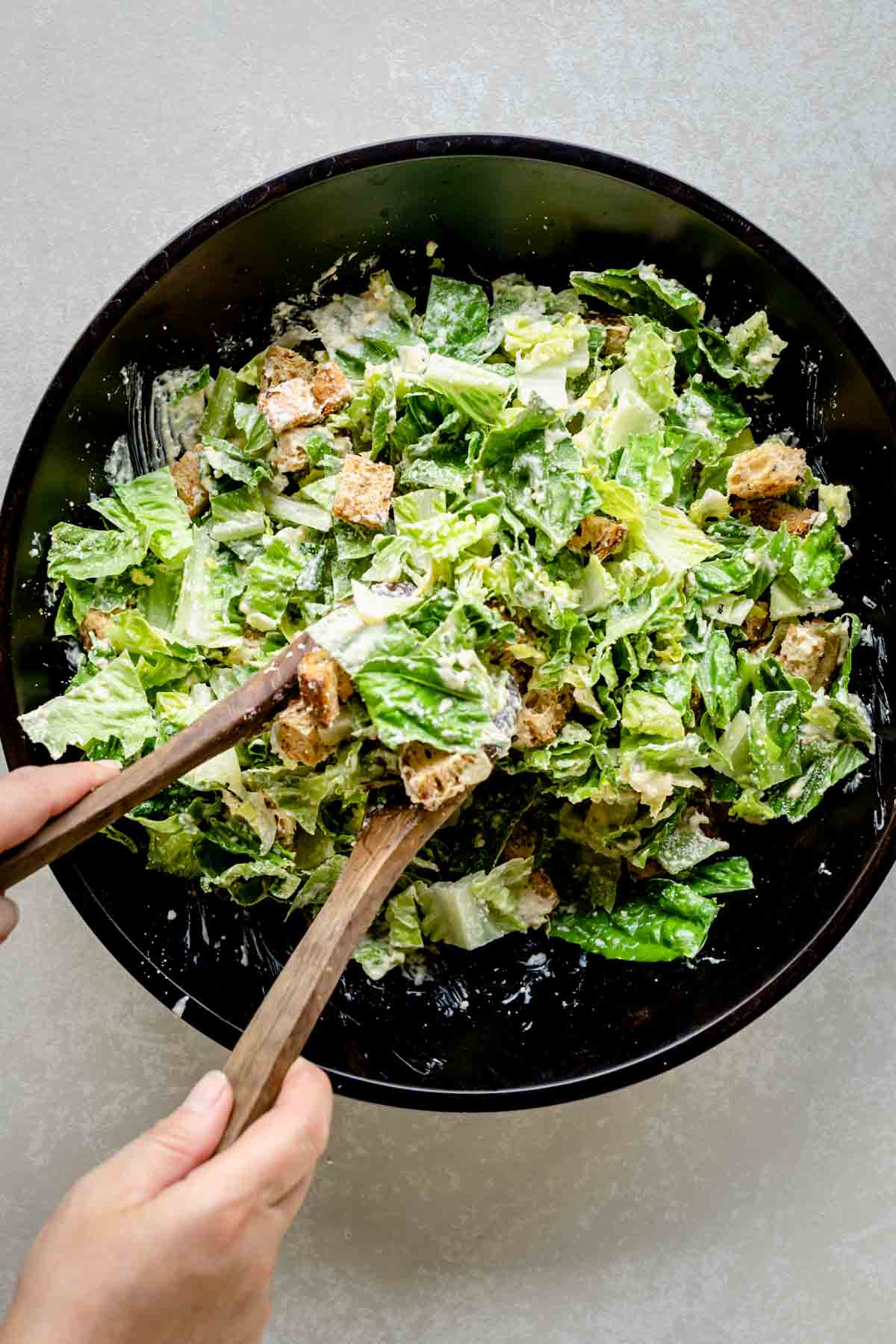
Ratios For The Perfect Caesar Salad
You can use as little or as much dressing as you like to suit your tastes. We tried experimenting with the amount of dressing to salad ingredients and we suggest using the following ratio as a starting point:
- 12 to 18 ounces of chopped Romaine (about 8 to 12 cups or 2 to 3 hearts of Romaine)
- 3/4 cup dressing
- 1 cup croutons
- 1/4 cup grated Parmesan cheese
If you like a lightly dressed salad, start with a little less dressing, or if you like yours nice and creamy add more!
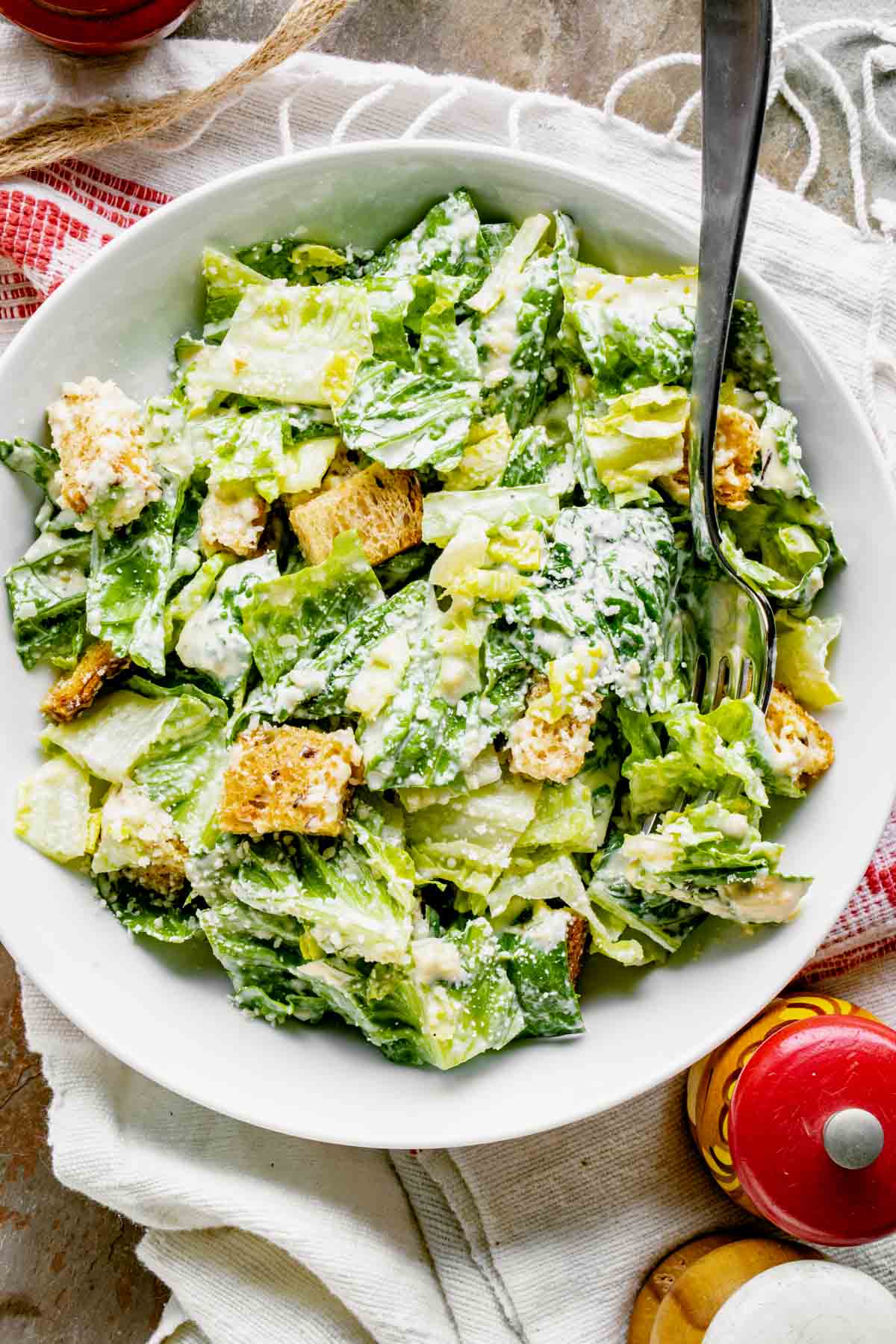
FAQs and Expert Tips For The Best Caesar Salad
How long does Caesar salad dressing last?
Caesar dressing can be made and stored in the refrigerator in a jar or resealable container for up to 5 days. After 24 hours in the refrigerator, the dressing will start to thicken.
If the dressing is very thick, use gloves (or clean hands) and toss the lettuce with the dressing to coat the lettuce evenly. You can also add a tablespoon of warm water to loosen it.
Can you make Caesar dressing without anchovies?
Anchovies are a classic component of Caesar dressing and give the salad a salty umami taste. If you are using canned anchovies that have been freshly opened, or paste, this dressing should not taste fishy at all. If you like restaurant-style Caesar salads, then you like anchovies in your Ceasar whether you know it or not. Every restaurant I have cooked in has used anchovies in their dressing.
Caesar Salad with No Anchovies is easy to make too! You can omit them if you do not like anchovies, do not eat fish, or are allergic. To compensate make sure to add a little more salt. Note that Worcestershire sauce also has fish in it, so you’ll want to find a vegan version too. Annie’s makes a good one.
Got leftover anchovies? Try our Puttanesca Sauce, Tomato and Anchovy Salad or this Lentil Celeriac Salad with Bagna Cauda Dressing. Anchovies that have been opened and exposed to air (stored in a jar in the fridge for example) do take on a more pronounced fish smell. I keep leftover anchovies in the freezer to help preserve their flavor.
A note on salt
My advice on salting your Caesar is to start with just 1/4 teaspoon of table salt (or 1/2 teaspoon Diamond brand kosher salt) in the dressing. In other words, go easy on the salt to begin- and add more to taste as you toss with the salad. The acid in the lemon and the salty ingredients have to be in harmony for the salad to have the right balance. There are several factors that will affect it:
- If you are swapping in another cheese- omit added salt in the dressing to begin/ then taste and add the salt to the tossed salad after the cheese is added.
- If you are skipping the anchovies- then you will need to compensate with more salt.
- If you took out some of the lemon- you will need less salt etc. But if it tastes too lemony- add a little more salt to balance it.
Other Mixing Methods
How to mix by hand
If you do not have an immersion blender (which is my preferred method) you can whisk the dressing by hand. Here’s how:
- Finely chop the anchovies if using whole fillets, and mince the garlic or grate it with a microplane grater.
- In step 1 whisk the ingredients in a large bowl.
- In step 2, make sure to drizzle the oils in very slowly and only add more if it is completely mixed in. Add the Parm as directed in step 3. The dressing will likely not be as thick but the flavors will still be good.
A note on making this in a blender
There is not quite enough liquid to reach the top of the blade to follow the recipe as directed so we tested it with the oil added right in with the yolk, lemon, anchovy and garlic etc. It worked beautifully in our Vitamix! We blended it on high for about 30 seconds with the oil and it came together nicely and the texture was just as thick and velvety as with the immersion blender.
To make in the blender:
- Add all the ingredients except for the Parmesan cheese to the blender.
- Cover and blend on high for 30 seconds.
- Remove the lid (it should be thick and aioli-like) and add in the Parm. Blend again.
What To Serve with Caesar Salad?
I feel like serving suggestions for Caesar is a topic that deserves an entirely separate blog post, but I’ll put a few favorite ideas here!
- Slow Cooker Turkey Bolognese over spaghetti is ideal for a Sunday Supper with family. All you need is this Caesar and warm rolls for a classic crowd-pleasing meal!
- Top your salads off with Seared Salmon or Crab Cakes for a date night in experience!
- Everyone loves a chicken caesar! Try with our classic Roast Chicken, Spice-Rubbed Roasted Chicken, this Island Chicken or our Garlic Herb Grilled Chicken to name a few.
Browse our Salad Dressing Collection
We have amassed dozens of homemade salad dressing recipes over the years. If you are a salad lover make sure to try some of these popular vinaigrettes and salad dressing recipes!
Don’t Miss These Other Classic Salads
Thanks so much for reading! If you are new here, you may want to sign up for my email newsletter to get a free weekly menu plan and the latest recipes right to your inbox. If you make this recipe, please come back and leave a star rating and review. I would love to hear what you thought!
Happy Cooking! ~Katie
Print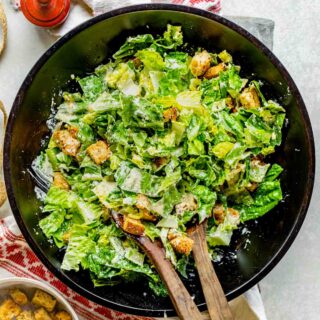
Caesar Salad Dressing Recipe
- Total Time: 5 mins
- Yield: 1 1/3 cups 1x
Description
This restaurant-style recipe for creamy classic Caesar salad dressing is made with raw egg yolk to emulsify the oil into the dressing. The results are a thick and creamy Caesar salad dressing that is tangy and lemony. It has bold garlic, Parmesan and anchovy flavors with a thick aioli-like texture.
Ingredients
- 6 anchovy filets or 2 teaspoons anchovy paste
- 1 egg yolk
- 1 clove garlic, peeled
- 3 tablespoons lemon juice
- 2 teaspoons Dijon mustard
- 3 to 5 dashes Worcestershire sauce
- 1/2 cup avocado oil or organic canola oil
- 1/4 cup olive oil
- 1/2 cup grated Parmesan cheese, plus 1/4 cup more for salad
- 1/4 teaspoon salt, or to taste
- Freshly ground pepper to taste
Instructions
- Combine anchovies, egg yolk, garlic, lemon, Dijon and Worcestershire in a blending jar, blender or mini prep. Puree with immersion blender, blender or mini prep.
- Add avocado oil and olive oil and puree until thick and completely combined.
- Add in ½ c Parmesan cheese and salt and puree. Keep refrigerated until ready to use.
Notes
To Make Salad:
Toss ¾ cup of this Caesar dressing with 18 ounces of chopped romaine lettuce or kale, ¼ cup more Parmesan and 1 cup croutons. For best results, use this dressing when it is freshly made or bring to room temperature. If the dressing is very thick, use gloves and toss by hand to coat the lettuce evenly. You can also add a tablespoon of warm water to loosen it if it is too thick. Once you toss with the greens and croutons, and additional cheese make sure to taste your salad. Adjust salt if necessary and grind on pepper and toss again before serving.
Make Ahead:
Caesar dressing can be made and stored in the refrigerator in a jar or resealable container for up to 5 days. After 24 hours in the refrigerator, the dressing will start to thicken. If your dressing is too thick to toss with the lettuce you can warm up the dressing at room temperature for a little bit, thin with a little warm water or toss the salad with gloved hands.
To Make Without Immersion Blender or Mini Prep Food Processor:
BY HAND: To mix the dressing by hand finely chop the anchovies if using whole fillets, and mince the garlic or grate it with a microplane grater. In step 1 whisk the ingredients in a large bowl. In step 2, make sure to drizzle the oils in very slowly and only add more if it is completely mixed in. Add the Parm as directed in step 3. The dressing will likely not be as thick but the flavors will still be good.
BLENDER: This can be made in a high-speed blender (like a Vitamix.) To do so add all the ingredients except for the Parmesan cheese to the blender, cover and blend on high for 30 seconds. Then remove the lid (it should be thick and aioli like) and add in the Parm. Blend again.
- Prep Time: 5 minutes
- Cook Time: 0 mins
- Category: Salad Dressing
- Method: Small Appliance
- Cuisine: American
Nutrition
- Serving Size: 3 tablespoons
- Calories: 252 calories
- Sugar: 0 g
- Fat: 26 g
- Saturated Fat: 4 g
- Carbohydrates: 2 g
- Fiber: 0 g
- Protein: 2 g

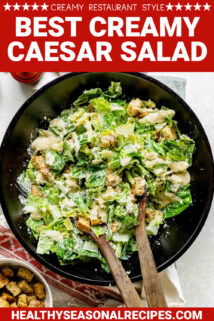
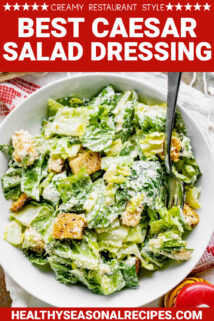
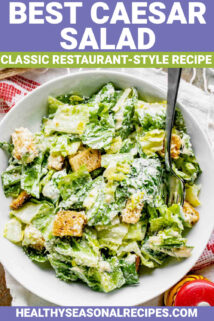
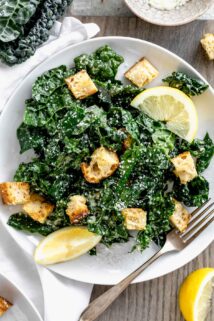
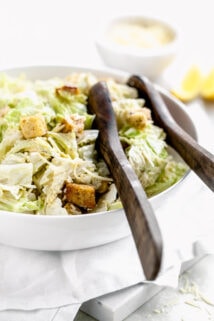
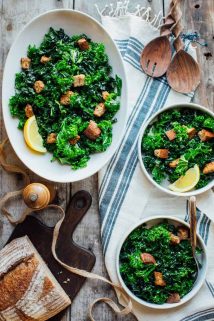
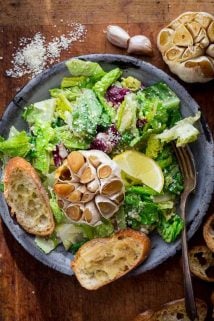
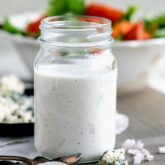
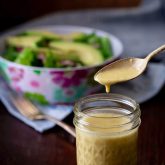

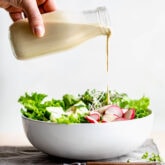
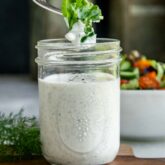
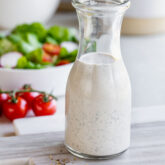
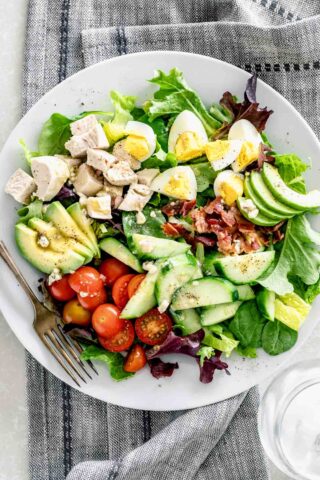

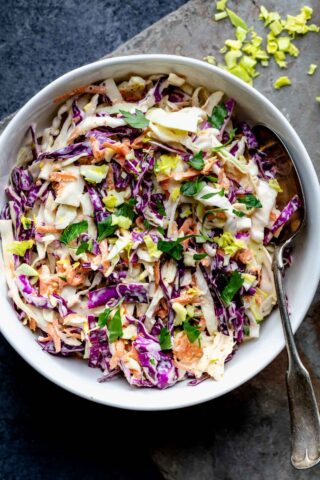



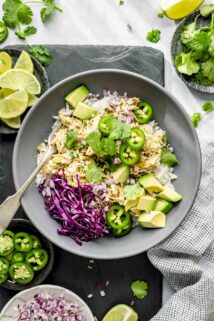
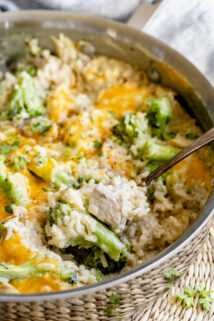


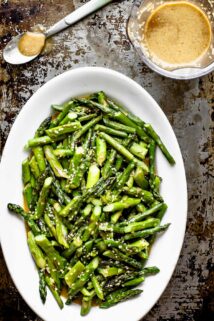
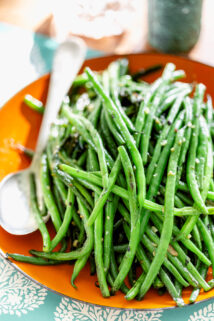


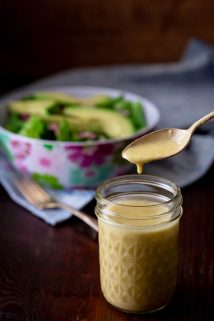


Great recipe! I did not know the recipe for Ceasar dressing, and this sounds yummy. A real lift for every salad.
I was wrong about too much oil- I hadn’t mixed it well enough!
I am glad you found that it ended up working out well! thanks for coming back to let me know that it did come together.
Way too much oil. Had to use other echoes to try to balance it out a little
I made this dressing and the Caesar salad and it was delicious. The dressing came out perfectly using my 35 year old Osterizer blender!
My parents had one of those Osterizers that I grew up with. I remember my mom using it for her hollandaise sauce. I think she still has it, come to think of it! I am glad you liked this recipe Carol. And as always, I really appreciate your coming back to leave a star rating. Cheers!
I never made caesar dressing at home. Your recipe looks so yum to not to give it a try. Thanks for all the wonderful tips and substitutions in the post as well!
I am glad to hear you were inspired by it.
You can’t beat a homemade dressing. So creamy and delicious.
Hi Dannii. I am happy that you tried this one and liked it!
Hey there! I wanted to drop by and give a quick shout-out to your post on Caesar salad dressing. Your recipe is an absolute game-changer! The combination of flavors in the dressing is simply divine, and it adds a delightful tanginess to the salad. I appreciate how your instructions are clear and concise, making it super easy to recreate this dressing at home. It will definitely become a staple in my kitchen, and I can’t thank you enough for sharing this gem. Keep up the fantastic work!
I am so happy that you tried it and that you’ll be making it again. That is great news!
I’ve never made my own Caesar dressing but I’m so excited to try it now! I love a good Caesar salad, especially once the weather starts to get warmer. Thanks for sharing!
Please report back once you do Nathan. Thanks so much for coming by and enjoy the rest of your week.
I love being able to make homemade salad dressings because you can use healthier, less-processed ingredients. This dressing is delicious! Adding Worcestershire sauce gives it a great flavor.
That’s great! Thank you so much for letting me know you tried it!